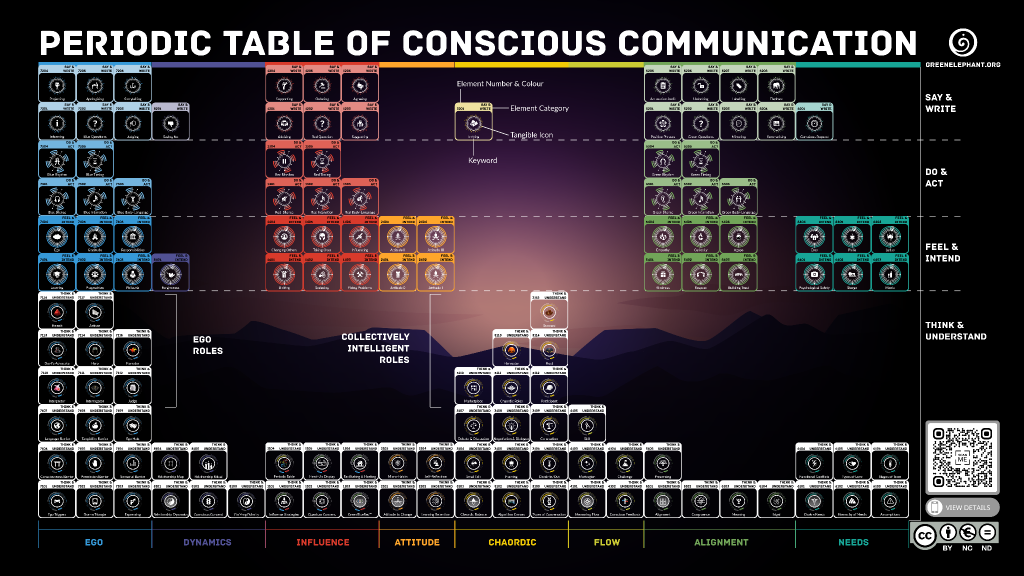In today’s globalised world, conscious or mindful communication is critical for building strong relationships with others. However, communication can be complex, and people often struggle to express themselves authentically while also being respectful of others. This is where the Periodic Table of Conscious Communication comes in – a tool that brings structure and clarity to the vast topic of communication, helping individuals gain a better understanding of the various elements that affect the way people understand themselves, each other and interpersonal relationships in general: https://greenelephant.org/content-restricted-private-download-of-hires-periodic-table/

4 levels
Just like the periodic table of chemistry, the Periodic Table of Conscious Communication is organised into four levels :
- Verbal
- Non-Verbal
- Intentions
- Thinking
The Verbal level focuses on what people say and write, including words, sentences, and scripts. The Non-Verbal level, on the other hand, focuses on what people do and their actions and behaviours, including rhythm, timing, silence, pauses, intonation, and body language. The Intention level is about what people feel, intend, and their focus of intention. Finally, the Thinking level is about what people think about communication, the mental models that shape the way we understand communication.
130 Elements
At the moment The Periodic Table of Conscious Communication contains 130 elements. Each element refers to a specific reality-tested conversation technique, non-verbal behaviour, rule-of-thumb, or visual mental model that has been identified as a fundamental component of conscious and mindful communication. Each element is like a building block that can be combined with others to create more complex communication strategies, much like the elements in the periodic table of chemistry can be combined to create compounds. The elements are organised into eight lenses that provide unique perspectives on communication. By understanding and practising these elements, individuals can become more skilled communicators and build stronger relationships with others.
8 lenses
The 8 lenses of The Periodic Table of Conscious Communication offer unique perspectives on communication patterns and behaviours. The Influence lens focuses on uniting people with conscious influence, while the Attitude lens harmonises learning with doing. The Chaordic lens hosts conversations with protocols and rules, while the Flow lens uses tensions as fuel for flow. The Alignment lens helps individuals share their intentions to build collective trust, while the Needs lens helps them own and express their needs. The Ego lens encourages individuals to take extreme ownership of their ego, while the Dynamics lens transforms toxic power plays into positive dynamics.
In conclusion, the Periodic Table of Conscious Communication is a powerful tool for individuals seeking to improve their communication skills and build stronger relationships with others. It provides a structured approach to understanding communication and offers practical solutions for applying conscious communication to various interpersonal relationships. By being mindful of one’s communication patterns and behaviours, individuals can create a more harmonious, empathetic, and productive world around them.
The Periodic Table of Conscious Communication offers a new language to think and talk about communication and helps individuals and teams to plan, monitor, adjust, and reflect on their communication behaviours. By practising conscious communication, individuals can become more self-aware, build stronger relationships, and resolve conflicts more effectively.

Conscious Influence – GreenBlueRed
The GreenBlueRed™ (GBR) element in The Periodic Table of Conscious Communication is a powerful tool for improving communication skills and building stronger relationships. In particular, the GBR under the Influence lens can help individuals learn how to fix problems by uniting people with conscious influence.
Influence is an important aspect of communication, and the GBR method provides a simple framework for understanding and utilising influence in a conscious and effective way without domination or manipulation.
The colours
- Red communication, which is focused on influencing and uniting people around actions that can be shared, is often the final objective or goal of our communication efforts. By using red communication strategically, individuals can help bring people together and solve problems in a way that benefits everyone involved. However, it is important to note that effective influence requires way more than just using red communication. To consciously influence others, individuals must first use green and blue communication in the right proportions and at the right times.
- Green communication, which focuses on building rapport and understanding, is essential for establishing trust and creating a positive relationship with the other person.
- Blue communication, which is focused on sharing information and ideas, is important for providing context and helping others understand the situation.
The order & proportions
When using the GBR method to influence others, it is important to remember the recommended proportions for each type of communication. Start with green communication, which should make up around 70-80% of the focus of your communication. Then, move on to blue communication, which should make up around 10-15% of your communication. Finally, end with red communication, which should be only 1-5% of your communication. That’s why the method is called 1.Green>2.Blue>3.Red!
By using the GBR method to consciously recognize and choose the right timing and proportion of each type of communication, individuals can analyse their behaviour and improve their ability to effectively communicate and connect with others. This can be particularly powerful in situations where there is conflict or disagreement, as the GBR method can help individuals unite people around a shared goal or objective.
In conclusion, the GBR element provides a powerful framework for fixing problems by uniting people with conscious influence. By using the right proportions of green, blue, and red communication, individuals can improve their ability to effectively communicate and influence others in a positive way. Whether you are trying to build stronger relationships, resolve conflicts, or achieve a common goal, the GBR method can help you achieve your objectives with greater ease and effectiveness.
For more info see this TedX talk: https://youtu.be/LZF8O85_0Jc


